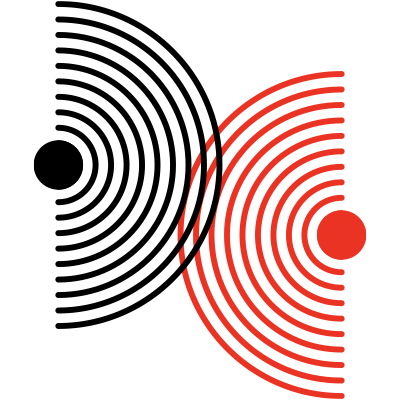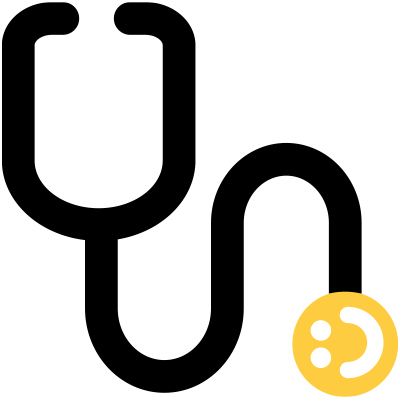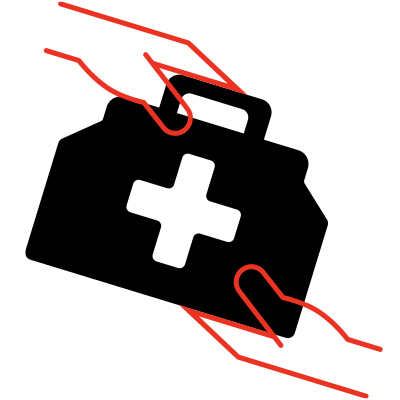
Johns Hopkins Professor of Medicine Mary Catherine Beach, who has been on a careerlong quest to improve communication between clinicians and patients, has had a revelation of late.
“Looking back on nearly 50 years of research and educational literature on communication in health care, I realized that virtually all the focus has been on how physicians should talk to their patients — not on how they should listen to them,” says Beach, who is co-director of CIM’s Center for Humanizing Medicine (CHM) and a Mary Gallo CIM Scholar.
Filling that gap in knowledge is crucial, Beach notes, citing a recent national survey measuring what patients look for when determining whether a doctor is trustworthy. “Some variation of, ‘the doctor listened to me’ turned out to be the most important predictor of building trust,” she says.
Patient trust isn’t just an abstract concept. Real harms can result when trust between patient and doctor isn’t there, she notes, including misdiagnosis or delays in diagnosis, ineffective treatment, unnecessary tests, psychological distress, medical errors and poor patient outcomes.
So Beach is actively sharing and advocating for the skills required for effective listening — first at a CIM Seminar last fall and more recently in February with a Grand Rounds presentation to hundreds of Johns Hopkins faculty, medical students and trainees. She’s grouped these skills into three main components:
1: ‘Epistemic Reciprocity’
This is a fancy term that simply means maintaining the belief that each participant in a conversation has “something important and valuable to say,” explains Beach. “It’s about sharing power. It’s about whose knowledge counts.”
In too many clinician-patient encounters, she says, a patient’s concerns go unheard or unaddressed — or even worse, are brushed off. “This phenomenon of being made to feel like you’re histrionic or exaggerating has been termed ‘medical gaslighting,’” Beach says, “and there are inequities by race and gender as to who gets taken seriously.”
For clinicians committed to listening better, a good start is to begin each patient encounter with curiosity and a sincere interest in what the patient has to say.
2: Overcoming Barriers to Careful Listening
It’s important to pay attention so we can understand what patients are saying, Beach says. But that’s not easy. “In general, people don’t listen carefully enough to each other; instead our mind is focused on what we are going to say in response,” she says.
For doctors, there are additional barriers to effective listening: relentless pressure to see more patients, the time-consuming electronic health record that needs to be updated, environmental noise, lack of sleep and general stress.
“On top of all that, as clinicians we need to listen with multiple ears and on multiple levels,” Beach says. “When a patient asks, ‘Do I need to take this medication for the rest of my life?’ is it an emotionally neutral question? Or are they concerned at a fundamental level that they are moving from being a healthy person to being an unhealthy person? We need to find a way to listen and understand on deeper levels, and to pay attention to emotional cues — but that’s difficult to do.”
“In general, people don’t listen carefully enough to each other; instead our mind is focused on what we are going to say in response.” – Mary Catherine Beach
3: Communicating You Have Heard and Understand
There are nonverbal ways clinicians can indicate they are paying attention, such as making eye contact, Beach notes. “And if we need to be on the computer, we can just acknowledge it directly. We might say something like, ‘I am going to type while you talk to make sure I get everything down.’”
Then there is the all-important reflection, which signals you understand the facts (“So this has been going on for six months”), are able to express an emotional response (“That sounds awful”), and acknowledge how the situation is impacting the patient’s identity or sense of self (“You’ve always been so active; this must have really changed your life.”)
For Beach, helping fellow clinicians to develop strong listening skills is an important key to advancing the mission of the CHM — “that is, to ensure that every patient is treated with dignity and respect and gets compassionate care.”
Don Willett May 21st, 2025
Posted In:

Practicing cardiologist Shiv Rao, who gave the 2025 Miller Lecture in May, is the CEO and founder of Abridge, an artificial intelligence-fueled system that is generating tremendous excitement among early adopters at Johns Hopkins and at hospitals across the country for its potential to humanize medicine.
Abridge uses generative AI to turn doctor-patient conversations into structured clinical notes that integrate in real time with electronic medical records. That relieves clinicians of the need to have their attention glued to the computer screen — rather than the patient — as they type in the seemingly endless stream of information required by today’s electronic systems. And patients can use an Abridge app on their phones to record their health care encounters, which creates a transcript that pulls out the most important points of the conversation for review later.
“Shiv Rao has revolutionized medicine by redefining both the patient experience and the provider experience,” says visionary Johns Hopkins radiologist Elliot Fishman, creator of the conversation series “Leading Change: Perspectives from Outside of Medicine” (see box). “It is a Renaissance man like Shiv — who has the computer background from Carnegie Mellon, medical training from the University of Pittsburgh as a practicing cardiologist and the humanity of learning from his father — who recognized that the most critical problem in medicine was the loss of humanity. All of that is changing and Shiv is leading a team at Abridge that is redefining our practices,” says Fishman, holder of the Elliot K. Fishman Professorship in Radiology.
Abridge is now being used by physicians at more than 100 health systems across the United States, including Memorial Sloan Kettering Cancer Center, Mayo Clinic, Duke Health and Johns Hopkins, where doctors praise it for reducing their administrative burden and allowing them to return their attention to patients.
“As a rheumatologist dealing with complex diseases, I rely strongly on the patient interview,” says Johns Hopkins rheumatologist Lisa Christopher, an Abridge user.
“Connecting with patients, taking an accurate history, and reassuring the patient that they are being heard is one of my favorite parts of being a physician.” Christopher is also part of Hopkins’ Colleges Advisory Program, where she teaches first-year medical students the art and practice of medical interviewing skills. “In recent years, I felt it was a bit disingenuous to model the medical interview for students like it was conversational with good eye contact. The reality was that I was frequently looking at a computer screen, badly typing, and hoping to try to maintain some kind of normal relationship with the patient that seemed genuine,” says Christopher, director of the Johns Hopkins Myositis Center. Abridge, she says “has brought back joy in medicine.” “It gives me back my natural communication style, as it allows me to look at my patient just like the ‘old days’ where I could appreciate the dialogue, eye contact and all of which makes human interaction such an important part of medical interviewing,” says the rheumatologist. “While there are still some growing pains, this digital scribe program has changed the way that I practice medicine for the better.” Rao has said he was inspired to create Abridge by his own experience (both as a physician and with his wife, as patients) as well as by that of his physician father, who had to retire early from medicine because “he just couldn’t type fast enough.”
“Connecting with patients, taking an accurate history, and reassuring the patient that they are being heard is one of my favorite parts of being a physician.” – Lisa Christopher
Rao’s lecture at Johns Hopkins in May marked the 22nd year of the annual Miller Lecture. Over the years, Miller Lecture speakers have varied — from authors to physicians, from poets to economists — but all have touched on a common theme: the crucial importance humanism holds for health and medicine.
The impactful series would not be possible, notes CIM Director David Hellmann, without the generosity of the Miller family — the late Mr. G. Thomas Miller and Mrs. Anne G. Miller, and their daughters and sons-in-law, Mrs. Sarah Miller Coulson and the late Mr. Frank L. Coulson Jr. and Mrs. Leslie Anne Miller and Mr. Richard Brown Worley.
Don Willett May 21st, 2025
Posted In:
 In an activity room at the Child and Adolescent Psychiatry Day Hospital, a group of young patients gazes at a large poster. Fantastical artwork by Kevin Peterson depicts a little girl with red hair and a blue dress strolling purposefully down a graffiti-filled urban street. Improbably, she is accompanied by a raccoon and a black bear.
In an activity room at the Child and Adolescent Psychiatry Day Hospital, a group of young patients gazes at a large poster. Fantastical artwork by Kevin Peterson depicts a little girl with red hair and a blue dress strolling purposefully down a graffiti-filled urban street. Improbably, she is accompanied by a raccoon and a black bear.
The young people share their observations about the artwork over the course of a guided discussion — which utilizes Visual Thinking Strategies (VTS) — led by pediatric psychiatrist Leslie Miller and adolescent psychiatry fellow Cami Burruss:
“With all that graffiti and the boarded-up buildings, I wonder if they’re safe.”
“Maybe they are headed to the forest.”
“I think they are looking out for each other.”
Miller and Burruss were aware that Johns Hopkins psychiatrist Meg Chisolm had found success using VTS with medical school learners to strengthen skills like observation, critical thinking and communication, vital for providing humanistic health care. The two adolescent psychiatrists believed VTS could also hold big benefits for children and adolescents coping with significant mental health issues.
So they applied for an impact grant (formerly microgrant) from CIM’s Center for Humanizing Medicine (CHM) and used the $1,500 they received to pursue training in VTS and to make laminated posters of different pieces of art and photography.
The duo’s idea was just one of 25 projects funded by the IHM in 2024 — and already many are bearing fruit, says Martha Abshire Saylor, Mary Ousley CIM Scholar.
“We were floored by the response when we announced the program last year. We received close to 100 applications from across The Johns Hopkins Hospital, Bayview Medical Center and Suburban Hospital!” says Abshire Saylor. “We are thrilled with the implementation of this first batch of grants. The point of this program is to make a small but mighty impact in improving patient care — and that’s just what is happening.”
She mentions a monthly “Spa Day” in the Medical Intensive Care Unit, for example, in which a nursing team wheels around a cart loaded with scented lotions and other care products used to lift the spirits of very sick patients through a little pampering. Or the tote bags stocked with sidewalk chalk, bubbles, a Frisbee and a jump rope, which are distributed to adolescents with HIV to encourage them to have fun and stay active. Or “buzzy bees” — small devices that convey a vibration on the skin aimed at distracting pediatric patients who are getting injections. “The pediatric nurses are very excited to use them,” says Abshire Saylor, who is CIM’s first nurse scholar.
For their part, Burruss and Miller have been heartened to see how the VTS art education groups they lead have helped young patients, including those suffering from social anxiety, to engage.
“These discussions help them with their ‘tolerance for ambiguity,’ since there is no right or wrong answer, and on identifying affect through nonverbal expression and perspective-taking as they identify with different characters and viewpoints,” says Miller. “These are all skills that are critical in mental health treatment.”
Adds Burruss, “There have been a number of times that we’ve shared with staff how a particular patient did a great job of participating and they are so surprised, saying, ‘Really? This person has never spoken up in a single group session!’”
The duo, who started with weekly sessions last September at the outpatient day hospital have since expanded to the Bayview campus, where they now lead VTS group discussions through the adolescent Intensive Outpatient Program. Psychiatric staff members at both clinics, buoyed by the participation they’ve seen in young patients, are now eager to get trained in VTS themselves so that they can lead discussions and expand the reach of the effort.
That’s exactly the kind of outcome that Abshire Saylor and other leaders of the CHM are hoping for with the impact grants.
“The goal is to make these creative efforts to improve patient care sustainable, so that the work can live on and even grow once the grant ends.” – Martha Abshire Saylor
“The goal is to make these creative efforts to improve patient care sustainable, so that the work can live on and even grow once the grant ends,” she says.
To further amplify the reach, Abshire Saylor is working on a research paper with Scott Wright, co-director of the CHM and the Anne G. and G. Thomas Miller Professor of Medicine. Through analyzing applications, they aim to describe and group together common “dehumanizing” problems patients experience that can be addressed through big ideas and small amounts of funding.
Seed funding through the CHM will continue. “We’ll be sending out a new request for proposals later this spring, with a plan to award funding to a new batch of projects in July,” says Abshire Saylor.
“Humanizing medicine is a dream,” she says, “but it can become reality as frontline clinicians notice the dehumanizing problems around them and get support to make an impact on patient care.”
Don Willett May 21st, 2025
Posted In:
 As engagement with the electronic medical record has taken time away from bedside interactions in medical education, rheumatologist Jason Liebowitz wanted to capture a crucial aspect of training that he sees, sadly, diminishing — the wisdom and insight gained from working with master clinicians.
As engagement with the electronic medical record has taken time away from bedside interactions in medical education, rheumatologist Jason Liebowitz wanted to capture a crucial aspect of training that he sees, sadly, diminishing — the wisdom and insight gained from working with master clinicians.
“There’s only so much you can gain from reading a standard textbook about clinical excellence or clinical reasoning. It doesn’t really convey what you get when you have the opportunity to work in-person, one-on-one with a true master clinician,” says Liebowitz, who completed his residency and fellowship training at Johns Hopkins and is now an assistant professor of medicine at Columbia University Irving Medical Center.
In an effort to convey these invaluable lessons in clinical excellence — on topics ranging from patient communication to mentorship to burnout — Liebowitz, along with Johns Hopkins rheumatologist Philip Seo, Lowe Family CIM Scholar, and Marcy Bolster of Harvard Medical School and Massachusetts General Hospital, solicited and edited a collection of 25 introspective essays from an interdisciplinary group of master clinicians who are also compelling writers. The result: Masterclass in Medicine: Lessons from the Experts.
Seo was Liebowitz’s fellowship program director at Johns Hopkins; the two first met when Liebowitz was in his residency. Both Johns Hopkins and CIM are well-represented among the group of authors, who weave together foundational stories from their own educations and careers.
CIM Director David Hellmann opens his chapter, “Partnering with Patients,” by retelling the time during his first year of residency, when he witnessed another physician pull a diagnostic rabbit out of the hat by asking the patient what the patient thought was causing the mysterious, multisystem illness that had stumped a team of doctors. The patient’s suspicion — that it was the fungal infection coccidiomycosis, borne from spores found in desert sand — turned out to be true. A truck driver, the patient had picked it up after driving through the California desert, and had recently read about truckers developing Valley Fever, another term for the condition. Hellman goes on to say that partnering with patients has “helped [him] become a better healer and added immeasurable joy, satisfaction, meaning, and wonder to [his] professional life.”
“Medicine is the most wonderful career in the world, and getting to know the patient is the most wonderful part of the practice of medicine.” – Roy Ziegelstein, vice dean for education, writing in Masterclass in Medicine
Roy Ziegelstein, vice dean for education at the Johns Hopkins University School of Medicine, contributed “Personomics,” a chapter on the term he coined that brings together the information physicians need to know to provide individualized care — the “psychological, social, cultural, behavioral, economic and unique life circumstances,” he writes. “Medicine is the most wonderful career in the world, and getting to know the patient is the most wonderful part of the practice of medicine.” He recalls the moment from his first year of medical school in which the concept was born, when a pupil asked if he’d rather be a technically skilled doctor or one who knew the patient well as a human being. He realized he didn’t have to choose one or the other.
Seo points to Suzanne Koven ’86, an associate professor of medicine at Harvard Medical School who was an assistant chief of service in the Osler Medical Residency, who explained in a recent authors chat what unites the writers of the book.
“She said what everyone had in common was the love that they have for their patients, the love that they have for learning, the love that they have for their colleagues — that all of them brought their love to the profession, and that’s what drives them forward,” he says. “Even though we, from the outside, think of them as masters, they are still learning eagerly from each other.”
Liebowitz hopes medical students and young physicians read the book to get the kind of bedside wisdom they might be missing.
“We want someone reading this book to feel like they’re having a conversation with these great doctors.”
Don Willett May 21st, 2025
Posted In:
Spring in Baltimore offers a sense of renewal, as daffodils, tulips and hyacinths push up out of the earth, bringing a riot of color and sweet scents. At CIM, a parallel can be found in the “blooming” of two especially promising clinicians. Their commitment to humanized medicine is bringing new hope and fresh ideas to countless patients and colleagues.
The first is pulmonologist Michelle Sharp, the Mary and David Gallo CIM Scholar and Elena and Everardo Goyanes CIM Scholar, who has an exciting new role: as assistant director of CIM.
“Dr. Sharp is known for her extraordinary diagnostic acumen and bedside skills, which she demonstrated as a resident and fellow and now as co-director of the Johns Hopkins Sarcoidosis Center,” says CIM Director David Hellmann. “In addition to handling operational aspects of CIM, Michelle will take the lead in planning and executing our CIM Seminars, which feature enlightening talks by faculty and guest speakers.”
“David has asked me to think about ways to bring in the patient’s voice to our CIM Seminars,” says Sharp. She took a first step in answering that invitation with her own presentation last fall: “Sarcoidosis: What It Means to Heal.”
Sharp delivered her talk in conversation with patient Heidi Junk, a member of the Johns Hopkins Sarcoidosis Patient Advisory Board. Junk gave a moving testimony about her 30-year “rollercoaster ride” of living with the debilitating condition. She said that the care she receives from Sharp and the sarcoidosis team at Johns Hopkins has made all the difference in the world.
“One of the most healing statements I have heard is when Dr. Sharp said to me, ‘I am sorry that you’re suffering,’” Junk shared. Turning to Sharp, she added, “You really listen to what my experience is and think about how together we can figure out the next best way forward. You see me as an individual and acknowledge all of the crazy stuff going on inside of me. In the past, healing was trying to go back to what I once was, before sarcoidosis came into my life. Now what I realize is that healing is moving forward. That’s very empowering. And you and the multi-disciplinary team are a part of that healing process.”
The second faculty member whose work has taken root and is thriving is infectious disease expert Seun Falade-Nwulia, director of the Johns Hopkins Center for Substance Use & Infectious Disease Care, whose efforts focus on humanizing the treatment of patients with chronic infectious diseases who are drug users.
Falade-Nwulia is the new Susan and Steven Immelt/Douglas Carroll CIM Scholar. In a CIM Seminar presentation she gave in January, she noted that she was among the first medical residents at Johns Hopkins Bayview to benefit from the Aliki Initiative, a novel medical curriculum in patient-centered care. That experience was formative, she said.
“What I learned from the Aliki Initiative, and what has stayed with me, is that people are not diseases. People are people. They have lives and if we understand their lives, we may be better positioned to impact their health,” she said.
Falade-Nwulia noted that she was particularly proud to hold a CIM Scholarship named for the late Douglas Gordon Carroll Jr., who launched the Department of Rehabilitation Medicine at Baltimore City Hospitals (which later became Johns Hopkins Bayview Medical Center) and who enjoyed a long and esteemed career at Johns Hopkins.
“Dr. Carroll was an exemplar of humanizing medicine,” says Hellmann. “I know he would be very proud to have his name attached to the work of Seun.”
Carroll’s daughter Susan Immelt, a longtime pediatric nurse at Johns Hopkins, who together with her husband Steve Immelt funded this award, concurred. She noted that throughout her father’s career, he was devoted to caring for patients who too often went overlooked. Said Immelt, “Seun is the perfect person to be this scholar.”
Don Willett May 21st, 2025
Posted In: